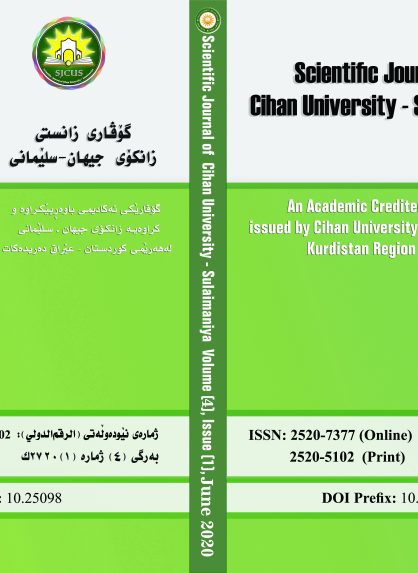| published |
| DOI
http://dx.doi.org/10.25098/4.1.7 |
أزمة العلاقات القطرية الخليجية وانعكاساتها على بورصة قطر
فلاح حسن احمد
قسم ادارة الاعمال، كلية التجارة ، جامعة السليمانية، السليمانية، العراق
E-mail: [email protected]
The Crisis of the Qatar-Gulf Relations and Their Repercussions on the Qatar Exchange
Falah Hassen Ahmed
Business Administration Department, Faculty of Commerce, Sulaimani University, Sulaimanyia, Iraq
E-mail: [email protected]
Received : 1-11-2019 Revised:24-11-2019
Accepted : 5-1-2020 Published :30-6-2020
الملخص:
يهدف هذا البحث الى دراسة تأثير أزمة العلاقات القطرية الخليجية في مؤشرات أسعار الأسهم وتأثيرها في نسب تداولات الأجانب في بورصة قطر، وتمثل مجتمع البحث ببورصة قطر، وطبق البحث على جميع القطاعات المدرجة في بورصة قطر كعينة للبحث وعددها 7 قطاعات، أما المدة التي يغطيها البحث فكانت بيانات على أساس شهري اذ امتدت من شهر آيار 2015 ولغاية حزيران 2019 . اعتمد البحث على اسلوب التحليل الاحصائي لاختبار فرضيات البحث ، وبغرض تحليل البيانات تم استخدام برنامج (SPSS – Version 24). وخلص البحث الى مجموعة من الاستنتاجات أهمها وجود تأثير سلبي لأزمة العلاقات القطرية الخليجية في مؤشرات أسعار الأسهم في بورصة قطر، كما توصلت الى ان نسب تداولات الأجانب لم تتاثر بتلك الازمة وقد قدم البحث مجموعة من التوصيات أهمها أن ادارة البورصة في حالة حدوث الأزمات ينبغي أن تعمل على اتخاذ الاجراءات اللازمة والتي من شأنها أن تحد من تأثيراتها السلبية على السوق وعلى الشركات المدرجة فيها، كزيادة نسبة تملك المستثمرين الأجانب من أسهم الشركات المدرجة.
الكلمات المفتاحية: الازمة القطرية الخليجية، مؤشرات أسعار الأسهم ، بورصة قطر
Abstract:
This research aims to study the impact of the Qatari – Gulf relations crisis on the stock price indices and their impact on the percentage of foreign trades on the Qatar Stock Exchange. The research community was represented on the Qatar Stock Exchange. The research was applied to all sectors listed on the Qatar Stock Exchange as a sample of research. On a monthly basis, it ran from May 2015 to June 2019. The research was based on the statistical analysis method to test the research hypotheses, as the program (SPSS – Version 24) was used in data analysis. The research concluded to a number of conclusions, the most important one is that there is negative impact of the crisis of Qatari-Gulf relations in the stock price indices in the Qatar Stock Exchange. It also concluded that the ratios of foreign trades were not affected by that crisis. To take the necessary measures that would limit its negative effects on the market and the listed companies, such as allow increasing the percentage of foreign investors owning shares of listed companies.
Keywords: Qatari-Gulf Crisis, Stock Price Indices, Qatar Stock Exchange.
المراجع
المراجع باللغة العربية
اولاً: التقارير والوثائق الرسمية
- التقارير الشهرية الصادرة عن بورصة قطر ابتداء من شهر آيار 2015 ولغاية حزيران 2019 .
- التقارير السنوية الصادرة عن بورصة قطر للاعوام 2008 و 2017 و 2018 .
- التقرير السنوي الحادي والاربعون لعام 2017 الصادر عن مصرف قطر المركزي، قطاع استقرار النظام المالي والاحصاء .
- تقرير آفاق الاقتصاد العربي الصادر عن صندوق النقد العربي، الاصدار التاسع، 2019 .
ثانياً: الدوريات
- عيسى، شقبقب ويحي، ازغار(2016)، ” محاولة قياس كفاءة السوق المالية الجزائرية مقارنة بتونس أعقاب الازمة المالية العالمية ” ، المجلة الجزائرية للعولمة والسياسات الاقتصادية ، العدد (7) .
- شندي، اديب قاسم (2013)، ” الأسواق المالية وأثرها في التنمية الاقتصادية- سوق العراق للاوراق المالية دراسة حالة ” مجلة كلية بغداد للعلوم الاقتصادية الجامعة، العدد الخاص بمؤتمر الكلية .
- عبد النبي، كريم (2006)، ” أهمية الدور الاقتصادي للاسواق المالية مع التركيز على السوق العراقية للاوراق المالية “، مجلة المنصور، العدد (9) .
ثالثاً: الرسائل والاطاريح الجامعية
- عكنوش، أحلام (2014)، ” سوق الاوراق المالية ودوره في تحقيق التنمية الاقتصادية- دراسة حالة الجزائر “، رسالة ماجستير، جامعة أم البواقي، كلیة العلوم الاقتصادیة والعلوم التجاریة وعلوم التسییر، الجزائر .
رابعاً: الكتب
- البرواري، شعبان محمد اسلام (2002)، ” بورصة الاوراق المالية من منظور اسلامي “، الطبعة الاولى، دار الفكر، دمشق .
المراجع باللغة الانجليزية
- Abdelbaki, Hisham H. (2010) “Assessing the Impact of the Global Financial Crisis on GCC Countries”, Journal of Business & Economics Research, Volume 8, Number (2).
- Al Refai, Hisham & Hassan, Gazi Mainul, (2018) “The Impact of Marketwide Volatility on Time-varying Risk: Evidence from Qatar Stock Exchange”, Journal of Emerging Market Finance, 17(2).
- Ali, Rafaqet & Afzal, Muhammad, (2012) “Impact of global financial crisis on stock markets: Evidence from Pakistan and India”, Journal of Business Management and Economics Vol. 3(7).
- El-Wassal, Kamal A. (2013) “The Development of Stock Markets: In Search of a Theory”, International Journal of Economics and Financial Issues, Vol. 3, No. (3). 606-624.
- Sana, Ashish Kumar & Mukherjee, Soumita & Raychaudhuri, Bibekananda, (2014) “Global Financial Crisis and its Impact on Indian Securities Markets: An Empirical Study”, Vidyasagar University Journal of Commerce, Vol. 19.
- Thalassinos, Eleftherios & Pintea, Mirela& Iulia, Raţiu Patricia, (2015) “The Recent Financial Crisis and Its Impact on the Performance Indicators of Selected Countries during the Crisis Period” International Journal in Economics and Business Administration, Volume 3, No (1).pp. 3 – 20.
- Nazir1, Mian Sajid, & Nawaz, Muhammad Musarat, & Gilani, Usman Javed, (2010) “Relationship between economic growth and stock market development” African Journal of Business Management Vol. 4(16), pp. 3473-3479.
- Tekin, Bilgehan & Yener, Erol (2019) “The causality between economic growth and stock market in developing and developed countries: Toda-Yamamoto approach”, Theoretical and Applied Economics, Volume XXVI, No. 2(619), pp. 79-90.
- Masoud, Najeb M.H. (2013) “The Impact of Stock Market Performance upon Economic Growth”, International Journal of Economics and Financial Issues, Vol. 3, No. (4), pp.788-798.
- Paramati, Sudharshan Reddy & Gupta, Rakesh. (2011) “An Empirical Analysis of Stock Market Performance and Economic Growth: Evidence from India”, International Research Journal of Finance and Economics Issue 73.



